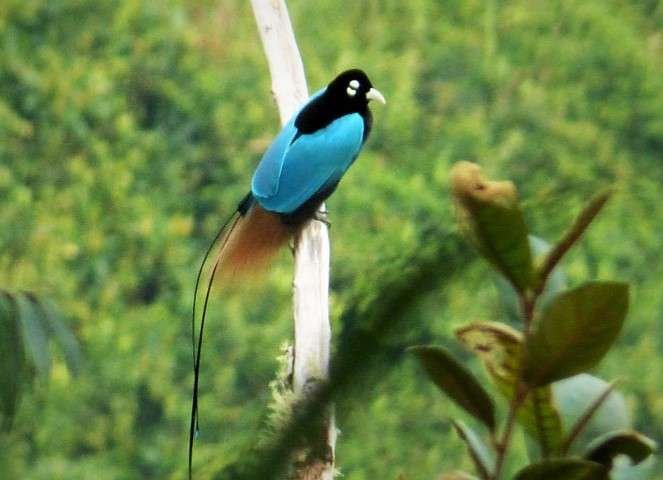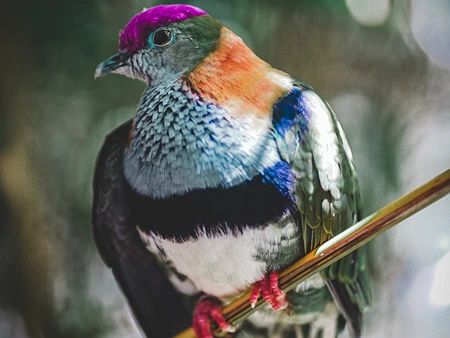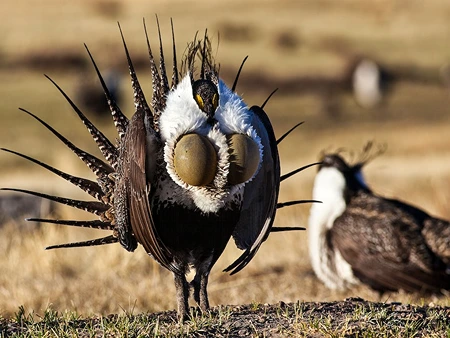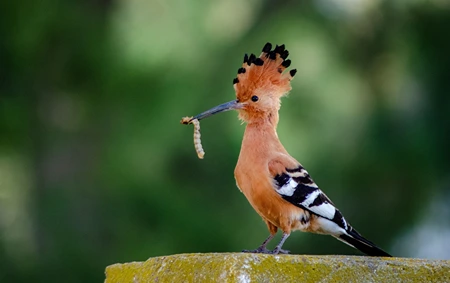Birds come in an incredible variety of shapes, sizes, and colors, and the ones we will be delving into are truly a sight to behold. Prepare to be dazzled by their vibrant plumage, intricate behaviors, and the wonders of the natural world.
Whether you’re a bird enthusiast or simply curious about the remarkable diversity of life on our planet, this article about birds will leave you in awe of nature’s creativity. So without much ado, let us dive into today’s article, 10 Dazzling Birds that End With E.
10 Dazzling Birds that End With E
1. Raggiana Bird of Paradise
| Scientific name | Paradisaea raggiana |
| Size | 13 inches |
| Habitat | Rainforests and montane forests |
| Location | New Guinea |
| Diet | Fruits and insects |
In particular, the Raggiana bird of paradise is famous for both its extraordinary beauty and courting rituals. The male Raggiana bird of paradise is a true spectacle of nature. It has velvety black feathers with extended, ribbon-like feathers that fall down its sides and a bright yellow crest.
These feathers, which may grow to stunning lengths, produce a beautiful show during the courting rituals of this bird. The male bird participates in complex dances, fluttering and hopping around the female while fanning its wings and tail feathers.
This dance accompanied by its unique calls creates a mesmerizing sight for anyone to witness. Sexual dimorphism in these birds is quite pronounced.
2. Purple Gallinule

| Scientific name | Porphyrio martinicus |
| Size | 10-15 inches |
| Habitat | Wetlands and marshes |
| Location | North and South America |
| Diet | Omnivorous |
With a medium-sized body and a vibrant array of colors, the Purple Gallinule is the second bird on this list of Birds that with E.
Its head, neck, and breast are a rich purple-blue, which contrasts with its brightly colored legs and huge yellow feet. Green, blue, and copper iridescent colors are used to decorate its back and wings.
The bill is red with a yellow tip, and its forehead is covered in a crimson shield. Birdwatchers and nature lovers are drawn to the Purple Gallinule’s eye-catching colors, which make it a visually appealing bird.
3. Blue Bird of Paradise

| Scientific name | Paradisaea rudolphi |
| Size | 30 centimeters |
| Habitat | Lower Montane Forests |
| Location | New Guinea |
| Diet | Fruits, seeds, insects |
Generally speaking, “bird of paradise” refers to a family of birds called Paradisaeidae, which are renowned for their visually appealing plumage and intricate mating rituals.
The Blue Bird-of-Paradise is a medium-sized bird with mostly blue plumage, elongated blue tail feathers, a distinctive pattern of iridescent scales on its breast, a bright blue patch on its head, and two curved, metallic greenish-blue plumes that extend from its nape.
The female, on the other hand, is less striking and has brownish-colored plumage. One of the most alluring sights for any nature enthusiast is the Blue Bird-of-Paradise’s spectacular courting displays.
4. Superb Fruit Dove

| Scientific name | Ptilinopus superbus |
| Size | 22-24 centimeters long |
| Habitat | Rainforests |
| Location | New Guinea, Australia |
| Diet | Fruits and berries |
Fruit Doves are hailed for their vibrant multicolor plumages, and the superb fruit dove is no exception to it. It has a striking color pattern, with the male having a bright green body with a deep purple head, throat, and upper breast.
The female, on the other hand, is less overtly attractive and has mostly olive-green plumage. A crimson eye ring and a thin black bill are shared by both sexes.
These gorgeous birds are predominantly frugivorous, and because they frequently ingest the fruits whole and then defecate the seeds in various regions, their diet serves a crucial function in seed distribution, assisting in the regeneration of forests.
5. Jambu Fruit Dove

| Scientific name | Ptilinopus jambu |
| Size | 9.0-10.5 inches |
| Habitat | Mangrove swamps and lowland rainforests |
| Location | Sumatra, Borneo |
| Diet | Fruits, especially the Jambu fruit |
Next up, on this list of Birds that end with E, we have another fruit dove species, the Jambu Fruit Dove. The vivid plumage of this stunning bird is well-known, and it enjoys eating a variety of fruits, particularly the jambu fruit, from which it derives its name.
The male and female of the Jambu Fruit Dove exhibit sexual dimorphism, with differences in appearance. The male has a pale pink abdomen and lower breast and a glossy, deep purple head, neck, and upper breast.
Its wings and back have a bluish-green color. The female, on the other hand, has a more muted color.
6. Great Crested Grebe

| Scientific name | Podiceps cristatus |
| Size | 18-20 inches long |
| Habitat | Freshwater lakes, marshes, reservoirs |
| Location | Europe, Asia |
| Diet | Fish, crustaceans, small amphibians |
The Great Crested Grebe is easily recognizable by its elegant and elongated neck, distinctive black crest on its head, and reddish-brown neck and body. Its plumage brightens during the breeding season, and the head and neck exhibit a striking combination of black and chestnut shades.
The intricate courting display of the Great Crested Grebe is one of the species’ most intriguing behaviors wherein males and females dance in unison, mirroring each other’s motions, making head-shaking displays, and giving each other aquatic plants.
7. Sage Grouse

| Scientific name | Centrocercus urophasianus |
| Size | 26-30 inches (males) |
| Habitat | Sagebrush ecosystem |
| Location | Western USA, Canada |
| Diet | Sagebrush, Wild lettuce etc. |
The Sage Grouse is a ground-dwelling bird species that inhabit the sagebrush steppe ecosystems, known for its unique appearance and fascinating mating rituals, making it a symbol of the western United States.
Males possess a prominent neck ruff of white feathers that they inflate during courtship displays, giving them a distinct appearance. Their plumage is predominantly mottled gray and brown, blending perfectly with their sagebrush habitat.
8. Grey Crowned Crane

| Scientific name | Balearica regulorum |
| Size | 3.3 feet |
| Habitat | Savannah |
| Location | Africa |
| Diet | Plants, insects. frogs, snakes |
The next bird on this list of Birds that end with E is the Grey Crowned Crane. It is renowned for its regal appearance, featuring a crown of golden feathers atop its head, composed of stiff, straw-like feathers that stand upright and give the bird a distinct profile.
This iconic bird is a symbol of grace and elegance in the avian world. Its long, slender neck, red inflatable throat pouch, and slender black legs further contribute to its enchanting appearance.
9. Tufted Coquette
| Scientific name | Lophornis ornatus |
| Size | 2.6 inches |
| Habitat | Open grasslands, gardens |
| Location | Venezuela, Brazil |
| Diet | Nectar |
Known for its striking plumage and unique physical features, the Tufted Coquette, one of the smallest hummingbirds in existence, captivates observers with its beauty and agility.
Its name comes from the tuft of elongated feathers on the crown of the male, which gives it a distinctive appearance. The male’s plumage is a mix of vibrant colors, with a glittering green back, a bright blue throat, and a white belly.
10. African Hoopoe

| Scientific name | Upupa africana |
| Size | 9.5-11.5 centimeters |
| Habitat | Open and bushy areas |
| Location | Southern Africa |
| Diet | Insects |
The last bird on this list of Birds that end with E is the African Hoopoe. The African Hoopoe boasts a striking plumage pattern, characterized by a combination of earthy tones.
Its body is predominantly chestnut-brown, adorned with black and white stripes and spots. One of its most notable features is the prominent crest on its head, which can be raised or lowered depending on its mood or level of excitement.
When the crest is fully raised, it creates an eye-catching display.
Now, its time to conclude this article on 10 Dazzling Birds that End with E. We have many more articles lined up, on a wide spectrum of niches, so make sure you keep a close eye. Until then, goodbye.
References:
- Palm Oil Detectives: Blue Bird of Paradise
- Animalia. bio : Grey Crowned Crane
- RSBP- Great Crested Grebe
Also Read:

A zoology student turned writer. Nature has always been a magnet to me, and to unearth some of its secrets through my articles is my prime intention. If not engaging myself with nature and anime content, you can always find me going through some Bengali classics or filling the air with some soulful Tabla beats. An artist, trying to throw some colors to my blank canvas of life.

